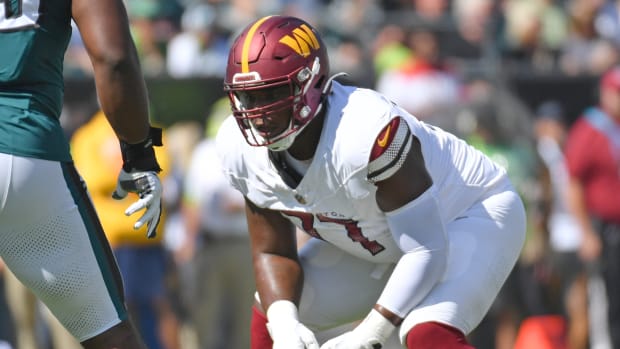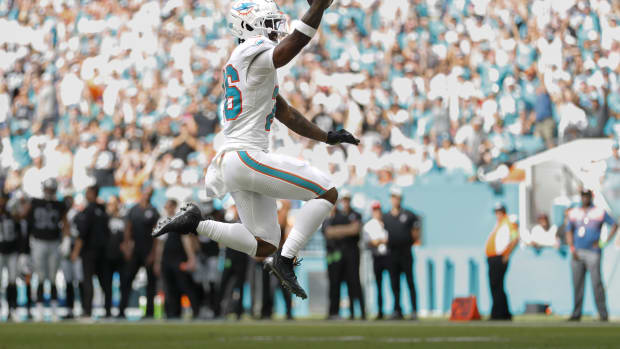Go Ahead, Doubt Ja'Marr Chase At Your Own Peril
Ja’Marr Chase was relatively new to the long jump. In fact, he had never competed in the event in any official capacity before his junior season of high school.
But there he was, at the Louisiana state track meet, gearing up for a jump. Chase’s father, Jimmy Chase, remembers it well. Two older boys made strong jumps ahead of Ja’Marr and were the toast of the event. The crowd roared for them, chanting their names and clapping their hands.
All it did was fuel and motivate Chase.
“I have an old saying,” Jimmy says. “‘You make Ja’Marr mad, he’s going to do something.’”
And Ja’Marr did do something on the track: he broke a 35-year-old school record, leaping 24 feet, 2½ inches in a mark that still hasn’t been bested and winning the state title.
If anyone didn’t realize Ja’Marr Chase was built differently, they did then.
“At the moment of conception, the Lord touched him and said ‘Player!’” says Tommy Moffitt, the strength coach at LSU when Ja’Marr played there from 2018-20.
Ja’Marr could jump far in track, dunk on the basketball court and catch anything thrown within his vicinity on a football field. He prioritized the latter and proceeded to shatter records on each level he’s played. At Archbishop Rummel High School just outside New Orleans in Metairie, Chase owns career, single-season and single-game receiving records. At LSU, he broke the SEC’s record for touchdown receptions in a season (20). As a pro in 2021, he had the most receiving yards in a game by a rookie (266) and receiving yards in a season by a Cincinnati Bengal. Roll up all of those records–the long jump too!-and Chase has already had a spectacular career, and he is just 21 years old.
But the track on which Ja’Marr Chase finds himself, one that has led to Sunday’s Super Bowl against the Los Angeles Rams, could have turned out much differently.
Think about it. What if he moved positions to defensive back? LSU coaches actually suggested this in the early days of his recruitment. What if he didn’t attend LSU and was never paired with quarterback Joe Burrow? Chase’s recruitment was a wild, wacky ride that included decommitments from two other schools. What if he never advanced beyond the immature freshman who was once dismissed from a position meeting?
“He and I had some … I threw him out of the meeting room one time,” says Jerry Sullivan, one of Chase’s college receivers coaches and longtime NFL tutor at the position. “He was better than most he was playing against. You could see it, you just had to get it out of him.”
It’s out now, shredding through the best football league in the world. His rookie stats are somewhat mind-bending. In a five-game stretch that included two playoff games, he had 642 yards receiving and caught 34 passes. He also has the third-most touchdowns in the league (13), the fourth-most yards (1,455) and fifth-most catches of at least 20 yards (22). He shattered NFL rookie receiving records set in 2020 by his good friend Justin Jefferson, a fellow New Orleans product who teamed up with Chase and Burrow to help deliver LSU the 2019 championship and now plays with the Minnesota Vikings.
For many in Baton Rouge, it looks like that season has extended into 2022 with the connection between Burrow and Chase now monopolizing the NFL.
“It’s like they just carried on, like it never stopped,” says Jack Marucci, LSU’s director of athletic performance innovation and a former athletic trainer at the school. “You see even the same routes.”
What makes Chase so different is his strength at the position. He is built more thick and sturdy like a running back. He’s nearly impossible to press at the line. His strength is his “secret” and it’s the magic that makes him so unstoppable, Jimmy Chase says. He remembers when Ja’Marr began lifting weights regularly in high school (he almost never missed a morning lift). His son started strutting around the house shirtless. Even if the Chases had company over, it didn’t matter. There was Ja’Marr bursting into the living room bare-chested.
“Put a shirt on!” Jimmy would snap at him.
“No!” Ja’Marr would yell back.
At LSU, Moffitt and his strength staff often measured a player’s “bar velocity,” which determined how quickly you moved the weight. In bench press, for instance, the clock started as soon as a player touched the bar to his chest. It stopped when he returned it to the rack. Bar velocity normally slows as weight increases, but no matter how much Moffitt loaded the bar, Chase’s bar velocity stayed the same.
“It tells you that he’s got power,” Moffit says. “He moves weight extremely fast.”
Weight. Opposing cornerbacks. Safeties. He moves everyone.
“You see DBs trying to grab a hold of them,” Sullivan says. “He sheds them. I taught him the technique–you shed them with that forearm. He’s strong like [San Francisco 49ers receiver] Anquan Boldin.”
Speed wasn’t an issue either.
“College coaches would come by and say, ‘How fast is he?’” recalls Jay Roth, Chase’s high school coach. “I’d tell them, ‘I’ve never timed him, but I’ve never seen anybody catch him.’”
Things weren’t always so easy for Ja’Marr. He grew up in a house with five older siblings on the West Bank of New Orleans in Gretna, a city south of the Mississippi River from the New Orleans central business district. According to the 2019 census, the median household income for Gretna was less than $50,000, and one-fifth of its population lived below the poverty line. Chase’s mother used to clean hospital equipment, while his father is a social worker. His older sisters and brothers constantly teased him and roughed him up, but he never quit, always running back for more bruises. Thoughts of college first began out of state–Chase was like many talented football players from New Orleans who, through a variety of forces, were steered to leave Louisiana.
“They’re always told, ‘Get away from this,’” says former LSU receivers coach Mickey Joseph, himself a native of New Orleans.
It didn’t help the state’s flagship school, LSU, and its head coach, Les Miles, suggested during a recruiting camp that Chase move to defensive back. That didn’t go over well with Chase. So, during a live spot on NFL Network the summer before his junior season, he was prepared to commit to TCU. But the broadcast ran long and Chase’s commitment got bumped. He didn’t commit at all. Six months later, he committed to Kansas and, within eight days, he decommitted. Just as his senior season started, he committed to Florida. A couple months later, he decommitted.
By that time, LSU had fired Miles. Ed Orgeron took over and hired Joseph as receivers coach, and the two poured much of their focus and resources on landing Chase.
“I don’t know what went on with him and Les, but we knew he was one of the top receivers in the country,” says Joseph, now on the staff at Nebraska. “Coach O looked at me straight in the eyes one meeting and said ‘Mickey, Ja’Marr Chase is coming to LSU.’”
Orgeron pulled out the stops and later wrangled the entire LSU coaching staff for a visit to Chase’s house before signing day. All 10 assistants poured out of a limousine shuttle and another SUV. Jimmy still has the photo–a keepsake and maybe the final move that convinced his son to stay in his home state.
During Chase’s freshman year, Joseph didn’t play him in a handful of games, fearing mistakes would hurt the team and his young player’s confidence. But the team gave Chase a chance in its Fiesta Bowl win against UCF, and he went on to set personal highs for yards (93) and catches (6). Joseph recalls saying to himself, “Momma, that giant done woke up.”
During LSU’s 2019 romp to the title, Chase led the FBS with 1,780 yards receiving (nearly 120 yards a game). He also eclipsed the 100-yard mark six times and the 200-yard mark in three games. It was enough to lead him to sit out his junior season, a move frowned upon by some but that seems to have paid off. He spent the off-year training in Dallas, studying film and watching his former college teammates struggle through to a 5-5 COVID-impacted 2020 season.
What many don’t know, his dad says, is Chase nearly returned to LSU midseason.
“People don’t realize how close he was to coming back,” Jimmy says. “After the third game, he was watching and jumped off the sofa after they lost. He said ‘I’m about to opt back in!’ It was killing him.”
The family seriously explored whether Chase would have been eligible to return (Jimmy says Ja’Marr would have) and spoke to coaches at length about his reinstatement. In the end, Ja’Marr remained on the sidelines. He went nearly two years without playing a game. During preseason camp and games in August, he dropped some passes and missed some routes. His father was an emotional wreck, fearing his son would drop off the draft map.
“When he started camp, I asked him and he said, ‘I’m not worried about them dudes,’” Jimmy says. “He knew he could play.”
Months later, he is playing in the Super Bowl and could match up against one of the best cornerbacks in the league, Rams cornerback Jalen Ramsey. Earlier this week, Sullivan read the comment and texted his former player. “Don’t let Ramsey get in your head,” Sullivan wrote.
And what if he does? That brings us back to Jimmy Chase’s old adage.
“You make Ja’Marr mad, he’s going to do something.”
More NFL Coverage:
• Burrow’s Rise to Stardom Wasn’t Easy—Just Ask His Parents
• The Bar That Became the Epicenter of the Bengals’ Run
• Joe Namath on Joe Burrow






































